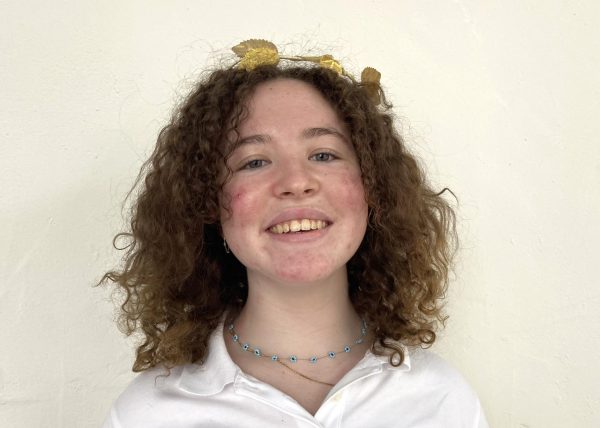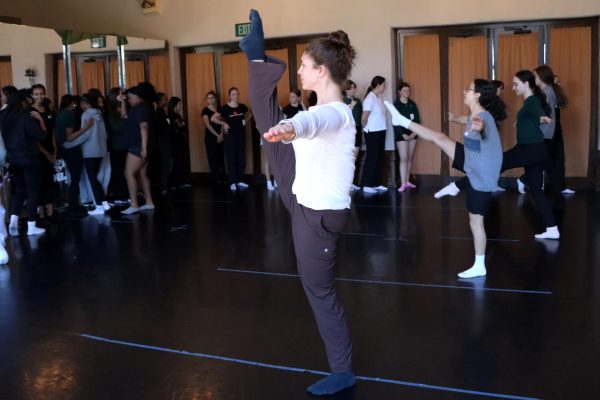Spotlight: How Andrea Locke danced her way to Archer
Photo credit: Nina Sperling
Dance teacher Andrea Locke gives dancers notes after a run-though during a Night of Dance tech rehearsal. This year, Locke organized the Night of Dance to take place in the main courtyard at Archer, Feb. 23, 24 and 25. She chose the theme, “Transformation,” as an ode to the impact the pandemic had on people all around the world and the return to in-person life. “No matter what’s being created on stage, even what the intention might be, the audience [brings] another intention or another perspective or another kind of feeling that connects,” Locke said.
Dance has always held a special place in Dance Director Andrea Locke’s heart. Her mother put her and her siblings in a recreation center’s dance program when she was 11 years old. Since then, Locke has been in productions ranging from George Duke’s “Shine On” music video, to “Motown 25” and more.
Locke performed her first solo to “Quiet Village” by Martin Denny in a modern dance class. In order to stay connected to movement, Locke was a part of dance, cheerleading and track programs all throughout middle school. She did not begin professionally training for dance until she started college at the University of California, Santa Barbara. Locke said she took ballet every day in college and because she did not have formal dance training, she said she had to work twice as hard as all of the other dancers around her.
Locke’s favorite styles of dance are jazz and modern dance. One of her first professional dance jobs was with a choreographer-dancer, Lester Wilson, who worked with Alvin Ailey, a dance pioneer who broke barriers by founding the Alvin Ailey Dance Theater and School, which features Black dancers and choreographers and is centered on the Black experience. Wilson also worked with Lester Horton, a dancer and choreographer who started the modern dance movement in Los Angeles and the first racially integrated dance company in the country. Wilson was a choreographer, dancer and actor who choreographed for productions such as “Saturday Night Fever,” and for artists such as Diana Ross and Gladys Knight. Locke said Wilson’s style of jazz was similar to what can be seen on “Motown 25,” a production that Locke was a part of later on within her career, and a style that she said she enjoys.
The Oracle sat down with Locke to discuss her career.
What made you decide you wanted to teach dance?
Andrea Locke [AL]: When I was in high school, I told my guidance counselor I wanted to be dancer. They said, ‘Half a percent make it as a professional dancer and less than that if you’re African American.’ So I get to UCSB and double major in dance and psychology. I decided to go and get my master’s from UCLA . I met a mentor in dance at UCLA, Jack Cole. He worked with Marilyn Monroe — he was in the film industry — and we would dance with him seven days a week. What I didn’t realize until later was that he had cancer, was dying and was giving every ounce of what he knew and had to this group of 20 dancers, which I felt privileged to be a part of. It was during that time that he said to me, ‘Don’t end up behind these four walls, you need to go and give your talent, give your joy, give your dancing to the world.’ Because of that, I started auditioning for professional things outside of college.
How did you get to Archer?
AL: Because of Jack Cole, I go to an audition — 300 girls. Many of them were dressed like showgirls. I come in with my modern dance outfit — long powder blue leg [and] body warmer — I came there to dance. I was the only one selected out of those 300 girls as a swing for a show called “$600 And A Mule” — that was my first professional show. My teaching came later after I performed in television, movies [and] lots of things. I was at a point where my kids started going to school and I started teaching there. I just fell in love with being able to share what I love and help other young people pull out a voice of movement and expression. So while I was there, I was recruited by Archer — someone recommended me, I got a call, I came to interview, I said, ‘Yes’ and that was 2005. I’ve been here since then, so Archer found me and I’ve loved it ever since.
Do you have anyone in the world of dance that inspires you or that you look up to?
AL: Besides Jack Cole, Twyla Tharp has a philosophy of dance and movement that I like. I didn’t like her movement at first but I love her philosophy, [as well as] Pina Bausch and Alvin Ailey. Alvin Ailey is different than the other people that I mentioned — I love his philosophy of dance and movement because it aligns with me. It’s about a person’s connection with their environment and the universe that brings a certain kind of energy that then connects with everybody else. I’m inspired by [Alonzo King‘s] philosophy, and he’s an excellent technician of dance. [He] sees the importance of having technique and being able to execute it. My inspiration comes from those, not just what I see them doing, but the way that they connect movement and life. I am always seeking to learn from even the up and coming, the newer [and] fresher perspectives on movement.
How have you seen dance or Night of Dance transform since you’ve been at Archer?
AL: When I first came, we used to have maybe 50-60 dancers in the show — [now], it’s gone from that to a vision. That set me on a trajectory of, ‘How do I create that? How do I make that happen?’ And I feel so fortunate to have the support of administration, especially Elizabeth [English], that not only was I able to [say], ‘Okay, I want to include everybody and anybody who wants to dance.’ When I started, it was a little bit more exclusive, so I opened it up to anybody who wanted to dance and made dance troupe. Later, I was able to create Dance Company. So, here we are – it’s lovely, it’s epic and magical.

Nina Sperling joined the Oracle in 2021. She became a senior reporter in 2022 and continued in that role for the 2023-24 school year. She loves spending...







![Dance teacher Andrea Locke gives dancers notes after a run-though during a Night of Dance tech rehearsal. This year, Locke organized the Night of Dance to take place in the main courtyard at Archer, Feb. 23, 24 and 25. She chose the theme, "Transformation," as an ode to the impact the pandemic had on people all around the world and the return to in-person life. "No matter what's being created on stage, even what the intention might be, the audience [brings] another intention or another perspective or another kind of feeling that connects," Locke said.](https://archeroracle.org/wp-content/uploads/2022/03/Locke-featured-image-900x600.jpg)